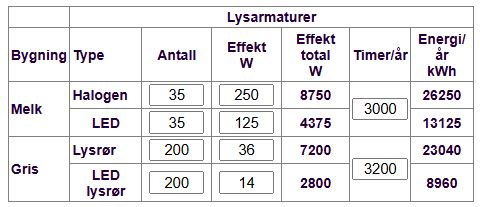In most buildings there is some form of vapor lamps, fluorescent tubes or halogen, and even if there is a good light yield from them, LED has gradually become so much better. Changing light fixtures from old types to modern LEDs can save approx. 50% of the energy.
New fittings are often considerably more expensive than traditional fittings, but usually this will pay off in savings in consumption. At Mære, the dairy barn has been switched to LED fixtures. If there are luminaires with fluorescent tubes, only the tubes and teeth can be changed and it will be cheaper. In the pig barn at Mære, the old fixtures have been changed from fluorescent tubes to LEDs. The saving is 13-14,000 kWh/year in each of the barns. Below you can see the calculation before and after.

The lifespan is often stated as 25,000-50,000 hours or more. This may sound like a lot, but if the light is on for 3,000 hours per year, it will be 30,000 hours in 10 years. In many of the LED installations, the light source cannot be replaced, but the entire fixture must be replaced if it goes out.
Another possibility with LED is different control of the light. With new lighting control, increased production can be achieved in dairy barns. Research is being done on day lengths, light levels and color composition.
Learn more about lighting in livestock rooms
The right light in the barn improves animal welfare and can increase milk production



